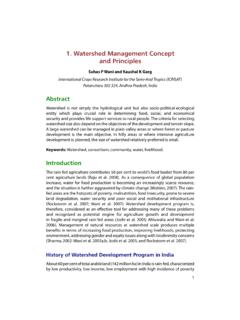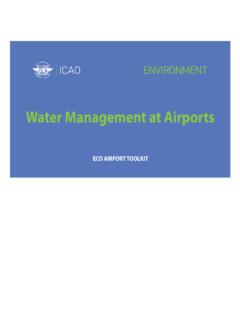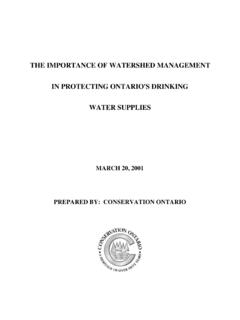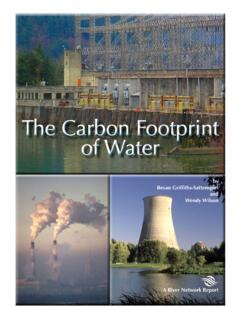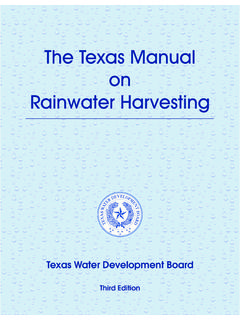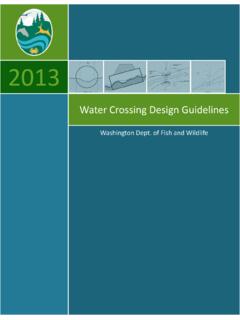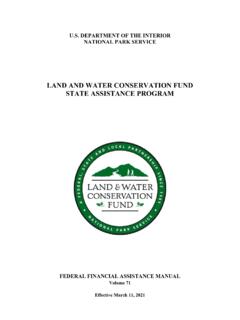Transcription of Small Acreage Irrigation Guide - Small Acreage Management
1 Issued in cooperation with USDA-Natural Resources conservation Service and Colorado State University Extension. All programs are available without discrimination. No endorsement of products mentioned is intended, nor is criticism implied of products not mentioned. water Rights and Irrigation Management Small Acreage Irrigation Guide Boyd Byelich Jennifer Cook Chayla Rowley Updated February 2019 1 AUTHORS Boyd Byelich District Conservationist, USDA-NRCS, Longmont, CO Jennifer Cook Small Acreage Management Coordinator, NRCS/CSU Extension, Brighton, CO Chayla Rowley Civil/Environmental Engineer, USDA-NRCS, Steamboat Springs, CO ACKNOWLEDGEMENTS The authors would like to thank the following individuals for technical and grammatical review of this document: Allan Andales, Assistant Professor in Soil and Crop Science, CSU Jos Chavez, Assistant Professor in Civil and Environmental Engineering, CSU Sean Cronin, Executive Director, St.
2 Vrain and Left Hand water Conservancy District Bill Haselbush, agricultural producer, Longmont Ray Jones, alfalfa Farmer, Adams County Brady McElroy, State water Management Engineer, USDA-NRCS Glen Murrey, wheat and hay farmer, Adams County Jason Peel, Irrigation water Management Specialist, USDA-NRCS Rick Romano, District Conservationist, USDA-NRCS Joel Schneekloth, Research Scientist, CSU Extension Mike Stonehaker, President of West Adams conservation District 2 TABLE OF CONTENTS Introduction .. 3 Considerations For water Users Frequently asked (or should be asked) questions: .. 3 Irrigation Systems .. 7 Estimating water Needs .. 11 Small -Scale water Pumps .. 16 Small -Scale Sprinkler Systems .. 20 Improving an Irrigation 22 Resources.
3 23 LIST OF TABLES Table 1: Irrigation Conveyance Efficiencies .. 8 Table 2: Irrigation System Comparisons .. 10 Table 3: Estimated Consumptive Use or ET (inches/growing season/acre) .. 11 Table 4: Estimated Average Weekly water Consumption .. 13 Table 5: Irrigation Depths Based on Crop Root Zone Depths .. 15 Table 6: Soil water Holding Capacity .. 15 Table 7: Pumping Across Horizontal Distances (0-20 feet change in elevation) .. 18 Table 8: Sprinkler System Selection Matrix .. 22 Table 9: Manufacturers Contact List .. 22 3 INTRODUCTION This Guide provides information about water rights and Irrigation for Small Acreage landowners. While the content is largely directed towards those engaged or interested in some form of agricultural production, it may also be useful for those simply interested in maintaining their yard and garden plot.
4 This Guide addresses many important questions about water rights and water use for landowners and for those thinking of purchasing land. Questions include: do I have water , can I get it, how much can I get, how do I determine how much to order, when can I get it, how do I get it, what will it cost, and what factors affect how much water ultimately ends up where I need it? Crop water requirements and Irrigation scheduling are discussed, and examples are provided to help the user with common calculations necessary for Irrigation scheduling and ordering the necessary amount of water to meet crop needs. In addition, information is provided on Irrigation systems that are appropriate for 5 acres or less, including pumps, pipelines, and water application options.
5 In short, this Guide is intended to help the water user get started with Irrigation , and to help all landowners better understand water rights and the legal use of water . CONSIDERATIONS FOR water USERS FREQUENTLY ASKED (OR SHOULD BE ASKED) QUESTIONS: 1. What is a water right ? It is a property right in the form of a legal decree that allows for the beneficial use of a measurable amount of water and is subject to the historical date it was first recorded. In fact, some of the earliest recorded water rights in Colorado date to the 1860s. A water right is usually limited to a specific volume of water described in terms of acre-feet (ac-ft), acre-inches (ac-in), or cubic feet-per-second (cfs), and limited to a specific beneficial use, such as agriculture or domestic uses.
6 2. Who owns the water right ? A person does not own the water . Rather, they have a legal right to use a specified volume of water for a predetermined beneficial use. In some cases, individuals own this decreed right. However, it is more likely that individuals have a pro-rata interest (share) in a right that is managed by a mutual ditch company. While the ditch company manages the water supply and delivery, the shareholders own the water rights held by the ditch company (Jones and Cech, 2009). Therefore, the landowner would have shares of water through their mutual ditch company. 3. What is a ditch company? Ditch companies as a group are typically referred to as a mutual ditch company and are similar to other corporations (ownership based on shares of stock), but organized to provide water to their shareholders on a pro-rata basis.
7 Ownership in a mutual ditch company is evidenced by a stock certificate (Jones and Cech, 2009). 4 4. What is a lateral ditch company? Lateral ditch companies differ from mutual ditch companies in that they do not own water rights. They tend to be smaller ditches that branch off from the larger ditches owned by mutual ditch companies. Their functions are to deliver water to the users along that lateral ditch and to maintain that ditch. They are separate legal entities from the mutual ditch company. It is very important to note that if your property is along a lateral ditch, then you need to be a shareholder in the mutual ditch company that delivers water to that lateral; otherwise you have no shares of water .
8 Conversely, if you acquire shares of water in a mutual ditch company, but your property is along a lateral ditch, then you will also need to have shares in the lateral company in order to receive your water . 5. What is a stock certificate in a ditch company? It specifies a predetermined amount of water (cfs, ac-ft, or ac-in) and is different for every ditch company. Within a ditch company, the amount of water allotted to a stock can vary by year, depending on the total available water supply that particular year. So, in a year of drought, the allocation of water for a particular ditch company may be less than it is during a year of average or abundant water supply. 6. How is my water measured? water is usually measured at the headgate of the ditch that delivers water to your property.
9 Shareholders on the ditch, or a ditch rider, open the headgate an incremental amount that allows the desired flow for the intended use on your property. The amount of water you may get is determined by the need of the crop at that point in time or your pro-rata interest in the ditch company, whichever is less. It is accurately measured by the size of the opening of the headgate or by using a device, such as a measuring weir or flume. 7. What is a ditch rider? A ditch rider is hired by the ditch company to maintain the ditch and open headgates as appropriate to divert water for water deliveries to shareholders in the ditch system. The ditch rider also calculates water volumes and oversees ditch operations.
10 The ditch rider stays in close communication with the water commissioner ( river commissioner) during the Irrigation season to coordinate water 5 diversions and calls on the river. Some of the smaller mutual ditch companies use a rotating ditch captain to coordinate ditch operation and maintenance activities (Waskom, 2011). 8. What is a call ? If a decreed water user has an insufficient water supply, they can make a request to the district water commissioner that all upstream, junior users curtail their use. This is known as placing a call . For a call to be valid, the shorted user must have a genuine need for water for purposes permitted by their decree, and there must be no downstream call senior to their own.

